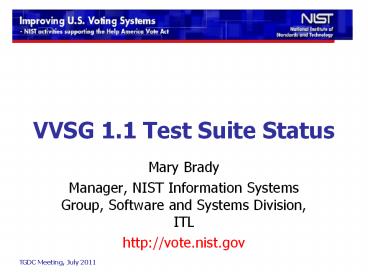VVSG 1.1 Test Suite Status - PowerPoint PPT Presentation
Title:
VVSG 1.1 Test Suite Status
Description:
Title: NIST Research on UOCAVA Voting Subject: TGDC Meeting 12/9/09-12/10/09 Author: Andrew Regenscheid Last modified by: Karen Yavetz Created Date – PowerPoint PPT presentation
Number of Views:53
Avg rating:3.0/5.0
Title: VVSG 1.1 Test Suite Status
1
VVSG 1.1 Test Suite Status
- Mary Brady
- Manager, NIST Information Systems Group, Software
and Systems Division, ITL - http//vote.nist.gov
2
Background
- Status quo Labs have been testing to VVSG 1.0
(2005) using proprietary, custom tooling and
review processes - In 2007-08, NIST developed a set of public test
suites for VVSG 2.0, to be used as part of the
EAC Testing and Certification Program - In 2009, to support VVSG 1.1, test methods for
new and changed material was back-ported from 2.0
test suites status quo prevails for everything
else
3
Test Validation
- NIST test suites have been rigorously traced to
VVSG requirements - Reviewed by independent parties, including the
EAC, VSTL labs, experts, and the public - Procedural validation has been on-going
- Operating temperature and humidity -- complete
- Usability and accessibility ongoing
- Core functionality, security under consideration
- Pursued obtaining in-house voting systems to aid
in the evaluation of NIST test suites
4
Recent Activities
- NIST met with each accredited VSTL to discuss
possible integration of core functionality tests - Recent activities regarding changes to VVSG 1.1
will require changes to the NIST developed test
suites delayed status of VVSG 2.0 warrants
additional focus on improving testing for VVSG
1.1, including existing methods for VVSG 1.0 - NIST and EAC met with both accredited VSTLs to
discuss ways to improve testing for the evolving
VVSG 1.1 and to integrate NIST-developed tests
into the certification process
5
Preliminary Findings
- To ensure consistency across testing
laboratories, agreed upon test methods must be
developed for all of VVSG 1.1 - Face-to-face meetings revealed differences in
interpretation of the term readiness test.
Labs read as acceptance test whereas NIST
definition was a simple health check - Some NIST tests require new election definitions,
which are problematic for the labs - Labs define test data separately from the test
case NIST defines them together
6
Additional Findings
- Some NIST tests should be reworked to take into
account practical test methods, with temperature
and humidity cited as an example - Source code analysis represents a large
percentage of the cost of testing tools remain
difficult to use - Reference ballots, including guidance on how
ballots should be marked (pre-marked,
hand-marked), election definitions/voting
patterns to be used, and complexity of
precincts/ballot styles, would be useful - Should identify priority areas outside of VVSG
1.1
7
Action Plan
- Monthly meetings among EAC, NIST, VSTLs, with
bi-annual face-to-face meetings - Focus on developing common test methods for new
VVSG 1.1, starting with information from EAC
matrix, NIST test suites, and existing VSTL
definitions - Validate NIST test suites and integrate into
certification process - Expand effort on source code analysis tools and
work with the VSTLs to develop rules for VVSG
1.1 - Explore creating a set of reference ballots to be
used by all labs
8
Discussion/Questions
Page 8































